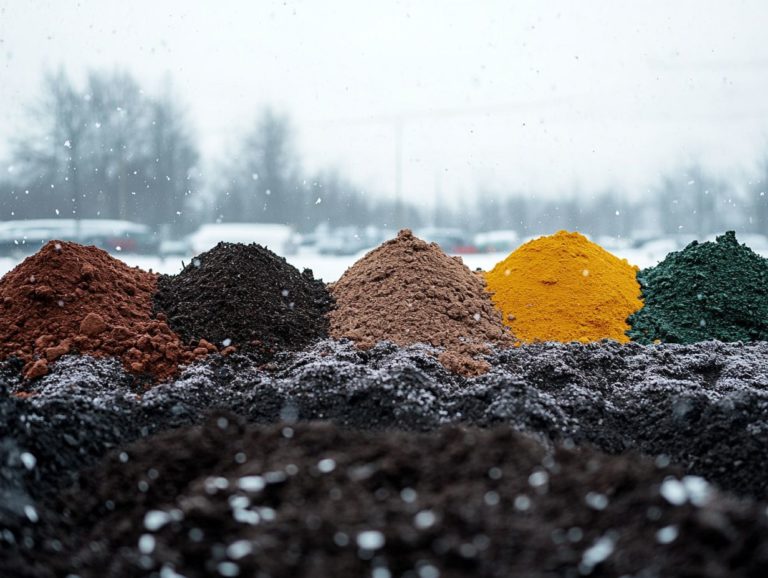How to Incorporate Organic Matter into Soil
Incorporating organic matter into your soil is a game-changer if you’re looking to elevate your sustainable gardening or farming endeavors!
By enhancing soil health and fertility, organic matter significantly boosts plant growth and nurtures a healthier ecosystem. This piece delves into various types of organic matter, such as compost and mulch. We will also highlight effective incorporation methods whether you prefer tillage or no-till techniques, both of which can affect soil properties.
You’ll find practical tips on how to customize your approach based on different soil types, including clay soil and sandy soil. Dive in and discover how you can transform your soil into a thriving foundation for your plants!
Contents
- Key Takeaways:
- Benefits of Incorporating Organic Matter into Soil
- Types of Organic Matter for Soil
- Methods of Incorporating Organic Matter
- Tips for Successful Incorporation
- Considerations for Different Types of Soil
- Frequently Asked Questions
- What is organic matter and why is it important to incorporate it into soil for soil health?
- How much organic matter should I incorporate into my soil?
- What are some common sources of organic matter, such as compost and manure, to incorporate into soil?
- How do I incorporate organic matter and soil amendments into my soil?
- How often should I incorporate organic matter and other nutrients into my soil?
- Can I incorporate too much organic matter into my soil, affecting soil pH and microbial life?
Key Takeaways:

- Incorporating organic matter into soil can greatly improve its quality and fertility, leading to healthier plants and higher crop yields.
- Compost, mulch, and other options are effective types of organic matter for soil, each with unique benefits and uses.
- When incorporating organic matter, consider the different techniques of tilling and no-till. Choose the best approach for your specific soil type, and consider soil pH and amendments like gypsum or Epsom salt.
Benefits of Incorporating Organic Matter into Soil
Incorporating organic matter into your soil enhances its health and promotes sustainable farming methods. Techniques include using mycorrhizal fungi and cover crops.
Ingredients like compost, biosolids, or biochar are rich in essential nutrients and stimulate microbial life, crucial for robust plant growth. Organic matter also boosts moisture retention and nutrient release. New amendments like peat moss can enhance soil structure.
Whether you’re working with clay soil or sandy soil, understanding the advantages of organic matter leads to cultivating healthier plants and achieving productive gardens, regardless of the challenges each soil type presents.
Improving Soil Quality and Fertility
Improving soil quality and fertility through organic matter is essential for your sustainable gardening and agricultural practices. This ensures better moisture retention and overall soil health.
When you incorporate organic amendments like compost, manure, and green cover crops, you enrich the soil and enhance its structure and nutrient-holding capacity. These amendments help beneficial microbes thrive, playing a vital role in nutrient cycling and overall soil health.
For instance, using compost tea promotes microbial diversity and enhances soil pH, fostering a rich ecosystem within the soil. Similarly, incorporating biosolids contributes a range of nutrients while improving water retention, soil properties, and aeration.
As organic matter decomposes, it releases essential nutrients like nitrogen and phosphorus, along with wood ashes, supporting crop production and resilience. By incorporating organic materials, you create a vibrant, self-sustaining soil environment that nurtures both plant growth and soil life.
Types of Organic Matter for Soil
Understanding the various types of organic matter available for soil amendment is vital for enhancing your gardening and farming practices. Options like compost, mulch, biosolids, and biochar each play distinct roles in enhancing soil health and fertility, while also contributing to moisture retention.
Incorporating cover crops, alongside the use of mulch and sawdust, can significantly enrich the soil ecosystem over time, ensuring a thriving environment for your plants.
Start improving your soil health today!
Understanding Compost, Mulch, and Other Options

Compost and mulch are among the most effective organic amendments you can use to enhance soil health and help nutrient release. Compost, crafted from organic waste, enriches tiny organisms that are essential for healthy soil. Mulch plays a crucial role in retaining soil moisture and suppressing weeds.
Each serves a distinct purpose in your garden ecosystem. Yet, they unite in their mission to enrich the soil. The preparation of compost involves breaking down kitchen scraps and yard waste through a controlled decomposition process. This yields a nutrient-rich material that nurtures beneficial microorganisms and enhances soil pH.
On the other hand, mulch is typically spread across the soil surface. It can consist of materials like wood chips, straw, or grass clippings. Its primary function is protective. While compost acts as a powerful fertilizer, gradually releasing nutrients, mulch also prevents erosion. It enhances soil structure over time, making it ideal for diverse gardening applications.
Together, these organic amendments not only elevate fertility but also foster a thriving habitat for soil organisms. This ensures a healthier garden environment for you to enjoy.
Methods of Incorporating Organic Matter
Use effective methods to mix organic matter into your soil for better results. You can significantly boost plant growth and improve soil structure, especially when using techniques like no-till methods or tillage.
Consider various techniques, such as tillage, no-till methods, or cover crops. Each offers distinct advantages and is tailored for different soil types, including clay soil and sandy soil, as well as various farming practices.
Tillage vs No-Till Techniques
The debate surrounding tillage versus no-till techniques often revolves around soil amendments and their influence on plant growth and moisture retention. This includes how manure and compost can improve overall soil health. Tillage can improve soil aeration and nutrient mixing. No-till approaches prioritize the preservation of soil structure and the reduction of erosion, making them vital for sustainable practices.
Think carefully about how each method affects soil health. Tillage often creates a loose topsoil environment that may accelerate initial plant growth. However, it can also result in increased moisture loss and shallow root development, which affects root systems.
No-till practices concentrate on maintaining a stable soil environment. This aids in moisture retention and encourages deeper root systems. This method is particularly advantageous for integrating organic matter, as it fosters beneficial microbial activity and nutrient cycling while promoting a vibrant ecosystem.
By evaluating these contrasting effects, you can make informed decisions that align with your crop productivity goals. They also promote long-term soil sustainability through the effective use of organic amendments.
Tips for Successful Incorporation
By implementing best practices for the successful integration of organic matter into your soil, including the use of gypsum and wood ashes, you can achieve remarkable improvements in both plant growth and soil health.
Adhering to established guidelines, such as proper timing and quantity, while steering clear of common pitfalls will ensure optimal results. This will also enhance the effectiveness of your soil amendments.
Best Practices and Common Mistakes to Avoid

Understanding best practices and common missteps is crucial for maintaining healthy soil and fostering microbial life.
Failing to properly decompose organic waste can dramatically influence the success of your soil amendments and gardening endeavors.
As a gardener or farmer, a thoughtful approach to when and how much organic matter to integrate is essential. For instance, adding organic amendments like manure and compost during the growing season can disrupt established plants.
It s also vital to strike a balance with the quantity of materials you use going overboard can lead to incorrect nutrient levels and potential nitrogen loss.
Embracing a variety of organic matter, such as compost, manure, and green cover crops, enriches your soil. However, failing to properly decompose organic materials before incorporating them can hinder nutrient release and affect microbial activity.
By staying attuned to these factors, you can ensure a thriving and resilient soil ecosystem. This supports your gardening aspirations and improves nutrient absorption.
Considerations for Different Types of Soil
When you contemplate incorporating organic matter into your soil, it’s essential to consider the various soil types, including clay soil and sandy soils.
Each type introduces its own set of challenges and opportunities, particularly in terms of moisture retention and how effectively organic amendments can work their magic.
Understanding these nuances will help you make informed decisions that enhance your soil’s health and productivity.
Adapting Techniques for Different Soil Types
Adapting your techniques for incorporating organic matter based on soil types, such as clay soil and sandy soil, is vital to explore!
Each soil type requires tailored approaches to enhance microbial life and improve overall soil health.
Understanding the unique characteristics of these soils like their drainage capacity, nutrient retention, and texture is crucial in determining the effectiveness of your organic amendments.
For instance, clay soil, with its fine particles, excels at retaining moisture and nutrients but often struggles with compaction and poor aeration. Conversely, sandy soil, made up of larger particles, drains quickly but can find it challenging to hold onto organic matter and nutrients, affecting overall soil health.
Thus, for clay soils, incorporating organic matter is vital to break up compaction and improve drainage. Meanwhile, sandy soils benefit from regular amendments, such as biochar (a form of charcoal that improves soil health), that help retain moisture and enhance nutrient absorption, ultimately fostering a thriving ecosystem that supports robust plant growth.
Frequently Asked Questions
What is organic matter and why is it important to incorporate it into soil for soil health?

Organic matter is any material that comes from living organisms, such as plants and animals. Incorporating organic matter is key because it improves soil properties and boosts nutrient levels, promoting healthy plant growth.
How much organic matter should I incorporate into my soil?
The amount of organic matter to incorporate into your soil depends on the type of soil you have and the plants you are growing. Generally, it is recommended to have at least 5% organic matter in soil for optimal plant growth.
What are some common sources of organic matter, such as compost and manure, to incorporate into soil?
Some common sources of organic matter include compost, manure, grass clippings, shredded leaves, cover crops, and biosolids. These can all be mixed into soil or used as a mulch layer on top.
Start improving your soil today for a thriving garden tomorrow!
How do I incorporate organic matter and soil amendments into my soil?
The best way to mix organic matter into your soil is by using a garden fork or tiller.
You can also layer it on top and let nature do the work, boosting moisture and helpful bacteria.
How often should I incorporate organic matter and other nutrients into my soil?
Add fresh organic matter every 1-2 years.
This keeps your soil rich in nutrients like Epsom salt and gypsum.
Can I incorporate too much organic matter into my soil, affecting soil pH and microbial life?
Yes, adding too much organic matter can upset nutrient balance and soil structure.
Stick to 20-30% organic matter for optimal soil health!






